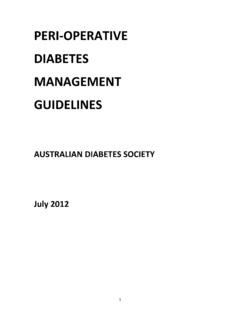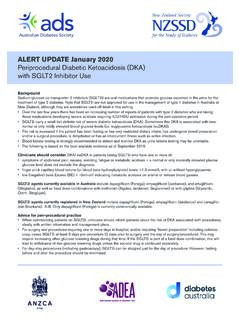Transcription of The Australian Obesity Management Algorithm - Diabetes …
1 The Australian Obesity Management Algorithm Introduction Obesity is a complex and multi-factorial chronic disease with genetic, environmental, physiological and behavioural determinants that requires long-term care. In 2014-15, of Australians aged 18 years and over were above normal weight, with being obese [1]. Obesity is associated with a broad range of complications including type 2 Diabetes , cardiovascular disease, dyslipidaemia, sleep apnoea, osteoarthritis, and certain types of cancers, which significantly impair quality of life. Obesity and its related complications place a considerable financial burden on Australia.
2 In 2014-15, the direct and indirect costs of Obesity were estimated at $ billion [2]. This statement has been developed by a working group with representatives from the Australian Diabetes Society, the Australian and New Zealand Obesity Society and the Obesity Surgery Society of Australian and New Zealand. Membership of the working group is shown in Appendix 1. The aims of the document are to: 1) Assist general practitioners (GPs) in treatment decisions for non-pregnant adults with Obesity 2) Provide a practical clinical tool to guide the implementation of existing guidelines for the treatment of Obesity in the primary care setting in Australia [3, 4].
3 Although the focus of this document is on weight loss interventions for the Management of Obesity , maintaining a healthy lifestyle and preventing weight gain in healthy weight or overweight individuals is an important and essential strategy to prevent a worsening of the current Obesity epidemic in Australia. Section1: Guiding principles 1. The benefits of weight loss Weight loss in people with Obesity has proven medical benefits in reducing the risk of Diabetes and other Obesity -related complications. For example, the 10 year follow-up of the US Diabetes Prevention Program showed that Diabetes incidence was reduced by 34% in the lifestyle group and 18% in the metformin group, compared with placebo [5].
4 The weight loss required to achieve some of these medical benefits is relatively small. For example, the reduction in Diabetes risk was achieved with weight loss in 1. the order of 5% [3]. However for some people with Obesity , this degree of weight loss may not meet their cosmetic expectations, despite the potential medical benefits. 2. The role of primary care Primary care is critical to addressing Australia's Obesity problem. Unfortunately there is a common view that little can be done to assist individuals with Obesity . This document illustrates that there are viable and effective treatment options but it is important that these are considered in the context that Obesity is a complex chronic disease that requires long-term ongoing care, with many similarities to managing Diabetes .
5 Management of Obesity in primary care requires a personalised approach, often in a shared care arrangement, with regular monitoring and the application of a variety of weight loss strategies, intensified over time if weight loss and health targets are not achieved. Routine and regular consideration and assessment of weight are essential initial steps that allow identification of: individuals whose weight is affecting their health and who may benefit from weight Management interventions individuals who are gaining weight and require counseling and weight Management interventions to prevent further weight gain Available resources could be better utilised in the Management of Obesity .
6 For example, individuals with Obesity are eligible for Medicare funded enhanced primary care plans including reimbursed allied health visits. In addition, people with type 2 Diabetes and Indigenous people are eligible for additional care plan services. 3. Weight bias Weight bias in Obesity care is a common and important obstacle that can interfere with effective Obesity treatment. Individuals with Obesity face persistent societal stigmatisation, prejudice and discrimination. Unfair treatment or prejudice because of body weight is referred to as "weight bias and translates into inequities in employment, education and also health-care.
7 Common negative stereotypes include obese individuals being lazy, unmotivated, lacking in self-discipline, less competent and noncompliant. Weight bias negatively affects psychological well-being and physical health. Weight bias is common among healthcare providers with accumulating evidence that individuals with Obesity are perceived as lacking self-control, unmotivated to improve health, noncompliant with treatment, and personally to blame for 2. their weight [6]. These attitudes affect outcomes and individuals with Obesity who perceive bias from their healthcare providers have less trust in them, experience more difficulty losing weight and avoid preventive health services and medical appointments.
8 Conversely, provider weight bias may result in less desire to help obese compared with thinner individuals. Healthcare professionals with Obesity may also be reluctant to give weight loss advice to their patients with overweight and/or Obesity . It is important for healthcare professionals to reflect on their attitude towards individuals who are obese and the potential for weight bias. 4. A personalised approach Weight and weight loss are sensitive issues for many people and most individuals with Obesity will have attempted multiple weight loss interventions and may not be ready to make another attempt.
9 Poor body image, low self-esteem, psychological problems and eating disorders such as binge eating and food addiction are common and will impact the effectiveness of treatment options. Health professionals should be aware that measurement of weight may in itself be upsetting for some people. The objective of reducing weight should be discussed at the outset and differing expectations between medical and cosmetic benefits reconciled. This should be used to inform the setting of individual realistic and sustainable weight loss targets according to the treatment selected.
10 Section 2: Treatment options for Obesity 1. Lifestyle interventions Supervised lifestyle interventions are an essential component of all weight loss strategies. Treatment goals focus on reducing energy intake and increasing energy expenditure. General advice on healthy eating is defined in the Australian Dietary Guidelines and the Australian Guide to Healthy Eating [7, 8]. Similar weight loss can be achieved with diets of different macronutrient content [9, 10]. Involving a multidisciplinary team such as an accredited practicing dietitian, exercise physiologist, lifestyle coach or psychologist should be considered and can be accessed through a chronic care plan.







